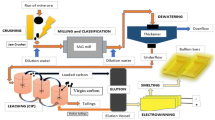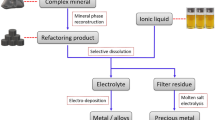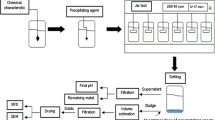Abstract
Bioleaching is a viable option for the processing of auriargentiferous refractory ores with high arsenic content. The application of mesophilic (A. ferrooxidans and “L. ferrooxidans”) and thermophilic bacteria of the genus Sulfolobus (S. solfataricus and S. acidocaldarius) as oxidant treatment before the cyanidation of an industrial arsenical pyrite concentrate is presented. The results show that extraction of gold and silver increases due to biooxidation caused by mesophilic bacteria and results in a maximum gold recovery of 68%. In all strains studied, biooxidation resulted in an average silver recovery of 50%. The results showed that all evaluated strains were sensitive to solids content (5 to 20%) and average particle size (75 and 38 µm) of the concentrate.
Similar content being viewed by others
References
Barrett, J., and Hughes, M.N., 1993, “The mechanism of the bacterial oxidation of arsenopyrite-pyrite mixtures: The identification of plant control parameters,” Minerals Engineering, Vol. 6, No.8–10, pp. 969–975.
Clark, M.E., Batty, J.D., van Buuren, C.B., Dew, D.W., and Eamon, M.A., 2006, “Biotechnology in minerals processing: technological breakthroughs creating value”, Hydrometallurgy, Vol. 83, pp. 3–9.
Gupta, C.K., and Mukherjee, T.K., 1990, Hydrometallurgy in Extraction Processes, Vol 2, CRC Press, USA, 262 pp.
Harrison, S.T.L., Sissing, A., Raja, S., and Nemati, M., 2003, “Identifying and quantitating biological responses of sulfolobus to high pulp density in the slurry bioleach reactor”, Proceedings of the 22nd International mineral processing congress (IMPC), L. Lorenzen and D.J. Bradshaw, editors, The South African Institute of Mining and Metallurgy, 1344–1354.
Johnson, D.B., 2006, “Biohydrometallurgy and environment: Intimate and important interplay,” Hydrometallurgy, Vol. 83, pp. 153–166.
Lindström, E.B., Sandström, A., and Sundkvist, J.E., 2003, “A sequential two step process using moderately and extremely thermophilic cultures for biooxidation of refractory gold concentrates,” Hydrometallurgy, Vol. 71, pp. 21–30.
Murthy, D.S.R., Kumar, V., and Rao, K.V., 2003, “Extraction of gold from an Indian low-grade refractory gold ore through physical beneficiation and thiourea leaching,” Hydrometallurgy, Vol. 68, pp. 125–130.
Nemati, M., Lowenadler, J., and Harrison, S.T.L., 2000, “Particle size effects in bioleaching of pyrite by acidophilic thermophile Sulfolobus metallicus (BC),” Appl. Microbiol. Biotechnol, Vol. 53, pp. 173–179.
Plumb, J.J., Gibbs, B. Stott, M.B., Robertson, W.J., Gibson, J.A.E., Nichols, P.D., Watling, H.R., and Franzmann, P.D., 2002, “Enrichment and characterisation of termophilic acidophiles for the bioleaching of mineral sulphides,” Minerals Engineering, Vol. 15, pp. 787–794.
Rawlings, D.E., 2002, “Heavy metal mining using microbes,” Annu. Rev. Microbiol., Vol. 56, pp. 65–91.
Stott, M.B., Watling, H.R., Franzman, P.D., and Sutton, D., 2000, “The role of iron-hydroxy precipitates in the passivation of chalcopyrite during bioleaching,” Minerals Engineering, Vol. 13, No. 10–11, pp. 1117–1127.
Tipre, D.R., and Dave, S.R., 2004, “Bioleaching process for Cu-Pb-Zn bulk concentrate at high pulp density,” Hydrometallurgy, Vol. 75, pp. 37–43.
Wang, H., Bigham, J.M., Jones, F.S., and Tuovinen, O.H., 2007, “Synthesis and properties of ammoniojarosites prepared with iron-oxidizing acidophilic microorganism at 22–65°C,” Geochimica et Cosmochimica Acta, Vol. 71, pp. 155–164.
Wiertz, J.V., Mateo, M., and Escobar, B., 2006, “Mechanism of pyrite catalysis of As (III) oxidation in bioleaching solutions at 30°C and 70°C,” Hydrometallurgy, Vol. 83, pp. 35–39.
Author information
Authors and Affiliations
Corresponding author
Additional information
Paper number MMP-09-056.
Discussion of this peer-reviewed and approved paper is invited and must be submitted to SME Publications Dept. prior to May 31, 2011.
Rights and permissions
About this article
Cite this article
Pecina, E.T., Castillo, P., Martinez, D. et al. Biooxidation of an auriargentiferous arsenical pyrite concentrate by means of mesophilic and thermophilic bacteria. Mining, Metallurgy & Exploration 27, 212–218 (2010). https://doi.org/10.1007/BF03402445
Received:
Accepted:
Published:
Issue Date:
DOI: https://doi.org/10.1007/BF03402445




